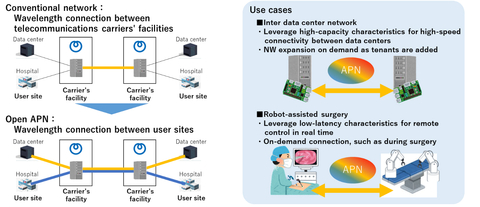NTT Conducts an Open APN PoC Jointly With Global Optical Product Vendors, Conducts a Field Test of On-Demand Wavelength Connection Technologies, and Enhances Its Capability to Develop Photonics-Electronics Devices
Summary
-
NTT Corporation (NTT), in collaboration with Ciena Corporation (Ciena), Fujitsu Limited (Fujitsu), and NEC Corporation (NEC), will conduct a joint PoC of Open APN1 defined by theIOWN Global Forum (IOWN GF)2. -
NTT will conduct a field test of its on-demand wavelength connection3 technologies to expand the application areas of APN. -
NTT will beef up its capability of developing photonic-electronic convergence devices by welcoming fJscaler Inc. as a subsidiary ofNTT Electronics Corporation (NTT Electronics ).

Figure 1. Overview of Open APN and use cases (Graphic: Business Wire)
Also, robot-assisted surgery systems have started gaining traction. The operators of such systems want to make them remotely operable to train more surgeons and save more people. However, this requires high-speed and low-latency network connections.
Addressing the above demands, in
Figure 1. Overview of Open APN and use cases
Open APN Joint PoC
The network nodes defined in the Open APN Functional Architecture can be constructed from the Open ROADM MSA’s4 standard components, which are available from global optical product vendors such as Ciena, Fujitsu, and NEC. To prove the viability and operability of Open APN,
The PoC should prove that Open APN is implementable and operable with products already available in the global market and encourage many organizations in the world to build and implement Open APN.
While conventional ROADM products are designed to create optical connections between telecommunication carriers’ sites, an Open APN creates connections between all endpoints, including customer sites. This difference leads to the need for new functions as listed below (Figure 2):
Figure 2. Functional requirements for on-demand wavelength connections between user sites
(1) |
A function for automatically designing and provisioning wavelength connections that satisfy service requirements by cooperation and coordination of terminals deployed in user sites and carrier equipment, and functions for selecting the best transmission mode, etc. |
(2) |
A function for configuring and managing optical wavelength end points of terminals deployed in user sites and a function for passing and blocking optical signals in carrier equipment based on the authentication status of each terminal |
(3) |
A function for adapting different types of optical fibers to be connected in the same optical wavelength5 |
Enhancing capability to develop photonics-electronics devices
To promote high-capacity, low-latency, and energy-efficient communications with APN,
Prospects
Future APNs will be capable of managing optical communication resources in cooperation with radio communication systems including 5G and beyond 5G. Due to NTT’s ongoing efforts with IOWN GF members, APN will become the infrastructure for future societies, enabling high-capacity, low-latency, energy-efficient communications for both fixed and mobile devices.
1 An innovative network based on photonics technology whose architecture is being openly developed at IOWN GF.
https://www.rd.ntt/iown/
2 A new industry forum that promotes the realization of a new communication infrastructure consisting of all-photonics networks, including silicon photonics, edge computing, and wireless distributed computing through the development of new technologies, frameworks, technical specifications, and reference designs to meet the data and information processing demands of the coming era.
https://iowngf.org/
3 A connection using a specific wavelength between optical transceivers. By occupying wavelengths between optical transceivers, low-latency and high-capacity communication are possible.
4 A Multi-Service Agreement that defines the interfaces and specifications that allow ROADM (Re configurable Optical Add-Drop Multiplexer) systems to interoperate between vendors.
http://openroadm.org/
5 A function for connecting multiple optical fibers with different wavelength bands without electrical conversion while remaining in the wavelength connection.
6 A project aimed at defining open technologies, architectures, and interfaces in optical and IP networks.
https://telecominfraproject.com/oopt/
7 https://www.ntt-electronics.com/en/news/2022/11/investment_in_fJscaler.html
About
###
View source version on businesswire.com: https://www.businesswire.com/news/home/20221214005266/en/
Media:
Account Manager
For
ngibiser@wireside.com
Source:







